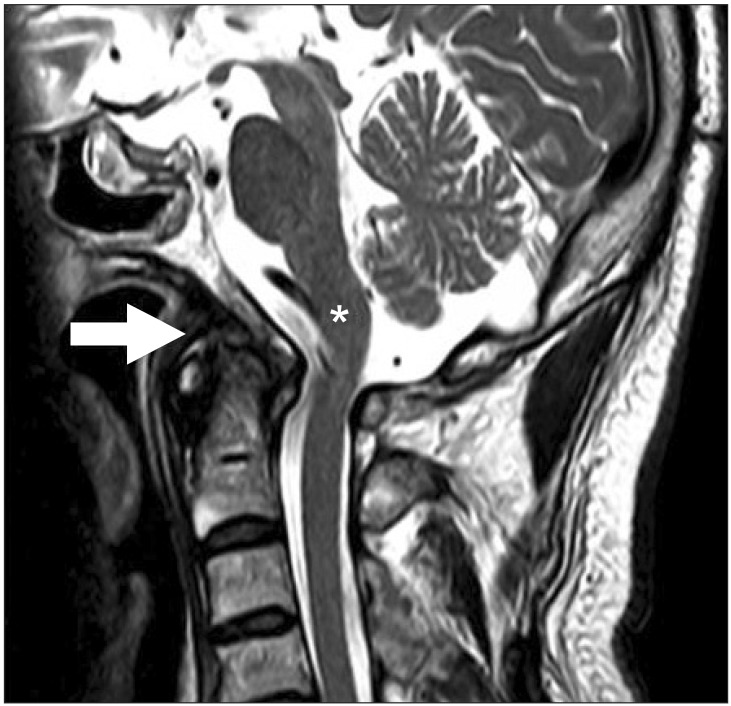Ann Rehabil Med.
2013 Jun;37(3):438-442. 10.5535/arm.2013.37.3.438.
Traumatic Atlanto-Occipital Dislocation Presenting With Dysphagia as the Chief Complaint: A Case Report
- Affiliations
-
- 1Department of Physical Medicine and Rehabilitation, Hallym University Chuncheon Sacred Heart Hospital, Hallym University College of Medicine, Chuncheon, Korea.
- 2Department of Physical Medicine and Rehabilitation, Hallym University Dongtan Sacred Heart Hospital, Hallym University College of Medicine, Hwaseong, Korea. ahyoungjun@gmail.com
- KMID: 2219544
- DOI: http://doi.org/10.5535/arm.2013.37.3.438
Abstract
- We report a patient with traumatic atlanto-occipital dislocation who presented with dysphagia as the chief complaint. A 59-year-old man complained of swallowing difficulty for 2 months after trauma to the neck. On physical examination, there was atrophy of the right sternocleidomastoid and upper trapezius muscles, and the tongue was deviated to the right. In a videofluoroscopic swallowing study, penetration and aspiration were not seen, food residue remained in the right vallecula and pyriform sinus, and there was decreased motion of the soft palate, pharynx and larynx. Electromyography confirmed a right spinal accessory nerve lesion. Magnetic resonance imaging confirmed atlanto-occipital dislocation. Dysphagia in atlanto-occipital dislocation is induced by medullary compression and lower cranial nerve injury. Therefore, in survivors who are diagnosed with atlanto-occipital dislocation, any neurological symptoms should be carefully evaluated.
Keyword
MeSH Terms
Figure
Reference
-
1. Ehlinger M, Charles YP, Adam P, Bierry G, Dosch JC, Steib JP, et al. Survivor of a traumatic atlanto-occipital dislocation. Orthop Traumatol Surg Res. 2011; 97:335–340. PMID: 21273154.
Article2. Diagnosis and management of traumatic atlanto-occipital dislocation injuries. Neurosurgery. 2002; 50(3 Suppl):S105–S113. PMID: 12431294.3. Traynelis VC, Marano GD, Dunker RO, Kaufman HH. Traumatic atlanto-occipital dislocation: case report. J Neurosurg. 1986; 65:863–870. PMID: 3772485.4. Olszewski J. Causes, diagnosis and treatment of neurogenic dysphagia as an interdisciplinary clinical problem. Otolaryngol Pol. 2006; 60:491–500. PMID: 17152798.5. Harris JH Jr, Carson GC, Wagner LK. Radiologic diagnosis of traumatic occipitovertebral dissociation: 1. Normal occipitovertebral relationships on lateral radiographs of supine subjects. AJR Am J Roentgenol. 1994; 162:881–886. PMID: 8141012.
Article6. Fujimura Y, Nishi Y, Chiba K, Kobayashi K. Prognosis of neurological deficits associated with upper cervical spine injuries. Paraplegia. 1995; 33:195–202. PMID: 7609975.
Article7. Cognetti DM, Enochs WS, Willcox TO. Retropharyngeal pseudomeningocele presenting as dysphagia after atlantooccipital dislocation. Laryngoscope. 2006; 116:1697–1699. PMID: 16955007.
Article
- Full Text Links
- Actions
-
Cited
- CITED
-
- Close
- Share
- Similar articles
-
- Traumatic Atlanto-Occipital Rotatory Posterior Dislocation Combined with Atlanto-Axial Rotatory Subluxation: A Case Report
- Traumatic Atlanto-Occipital Dislocation: A Case Report
- Atlanto-Occipital Dislocation: A Case Report
- Atlanto-occipital Assimilation Can be Misdiagnosed as Atlantoaxial Dislocation: A Case Report
- Transoral Fusion of Atlanto-axial Dislocation




